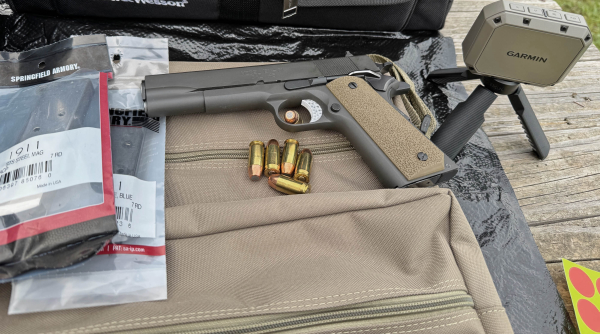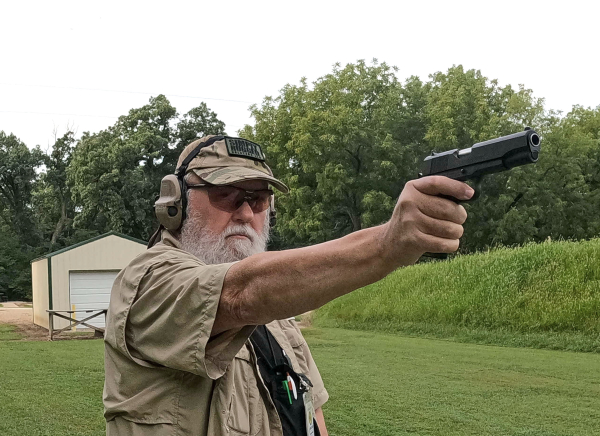Years ago, I’d written that I was early to the 1911 game; it was, in fact, nearly the only relevant game in town as far as auto-loading pistols. It was still the US standard service pistol, 45 ammo was available – nearly all of it was 230 grain FMJ “hardball.” There was some rarer, for bullseye centerfire matches, “softball,” a short 185 grain FMJ SWC meant for target shooting. In many, though not all, guns it required a lighter recoil spring and even then, reliability was suspect.

Lightly modified Springfield Armory (IMBEL) Mil-Spec, Actions by T components, ERGO Grips, and flat-point, open-tip ball ammo of uncertain vintage.
As time went on, Jeff Cooper noted that Army Colt needed only sights that are quickly visible, a usable trigger, “softened” edges and it must be made reliable.
My efforts to achieve that varied over time, during which I tried a Springfield Armory Mil-Spec. Made at that time by IMBEL, it was M1911A1 all the way – except for the sights, which were high enough to be picked up.
My example, roughly parkerized, worked and it shot well enough. I met Teddy Jacobson, “Actions by T” on a trip to an NRA Convention in Houston. He helped me out with some action parts and, ultimately, he fitted an Ed Brown thumb safety and Ed Brown flat mainspring housing.
I shot the gun for an article and away it went. I was hip-deep in the then-current striker-fired 9mm and 40 caliber guns. As I’m reliving my not-much-younger years, I got the Mil-Spec out for a reexamination.
At the time, I’d installed 1911 stocks from Ergo-Grips. These are fabricated of a hard injection-molded polymer material. They’re rough textured, feeling somewhat like skateboard tape. Called the “ERGO-Grip XT (Extreme),” the stocks fit just fine.

The gun was fired one-handed, with either hand, slowfire on a B-8 repair center. The recoil may appear extreme, but it’s a “push,” not a “snap.”
I took the early Springfield to the range to shoot an evaluation that I’d already used on other Government-pattern pistols. This consists of ten rounds, slow fire, from 25 yards on a B-8 repair center – as I have plenty of these. Five rounds are fired right hand unsupported. The target is marked and noted, then five rounds are fired with the left hand, also unsupported. This doesn’t show the accuracy of the pistol with particular ammo as well as it shows me how well I shoot the pistol. It also points up some issues with failing to fully depress the installed grip safety, among other things. I’m going more for group size than score, though I find that these guns are thus far hitting fairly close to the bull, my grip issues notwithstanding.
I follow it up with a gun handling drill, starting close shooting in a bent-arm, close quarters style, then shooting failure drills and high percentage exercises.
The slow fire score was 81/100, with the southpaw giving me five more points than the “strong” hand. I tended left with either hand, likely a grip issue.
The bent-arm CQ shooting at around ten feet from the target yielded center initial hits, followed by high fliers on the second and third string – firing ahead of my ability to get back in line after recoil.
All hits were on paper and all but two in solid scoring zones on the First Person Safety FPS-1 target printed locally.
The gun started with each of three magazines loaded to capacity – the factory supplied magazine from “back when,” and a pair of recently purchased Springfield Armory branded GI-style magazines. The gun was loaded, chambered, mags exchanged and the depleted magazine was bumped back up to seven rounds. That gave the total load out of 21 rounds, as if I were carrying the gun for duty.
I can report that all of the rounds – of unknown vintage and pulled from an ammo can – fed, chambered, fired, extracted and ejected. All hit the paper, just not exactly where I intended. A velocity check of five rounds yielded 840 fps from the Mil-Spec barrel.
Accuracy was better than I could hold – from the ca. 2005 “bottom of the line” gun from Springfield Armory.
Springfield Armory still makes the Mil-Spec. If it’s as good as this one, they’re smart to keep it in the line.
— Rich Grassi